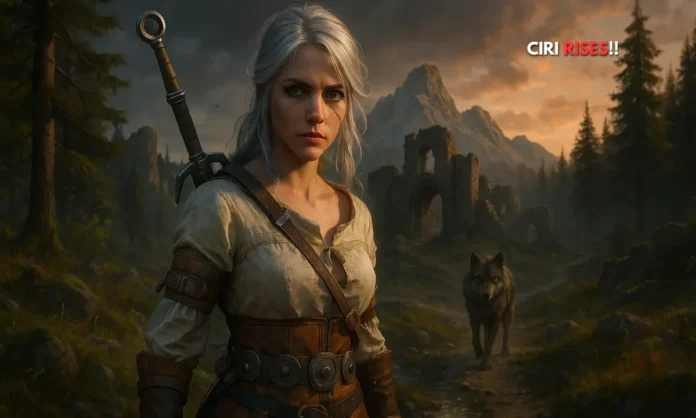Summary
- CD Projekt Red’s Witcher 4 debuts Ciri as the protagonist in a stunning tech demo powered by Unreal Engine 5.6.
- The seamless blend of cinematic and gameplay, advanced physics, and nanite-rendered environments set new standards for RPG immersion.
- While a 2026 release is confirmed, Witcher 4 may align with next-gen console launches, hinting at a cross-generational evolution.
Ciri’s Moment, Sony’s Milestone: How Witcher 4 on PS5 Is Rewriting RPG History
CD Projekt Red’s showcase of Witcher 4 at the State of Unreal 2025 wasn’t just a tech demo — it was a declaration. On a standard PlayStation 5, the Polish game studio revealed a near-flawless union of next-gen game physics, rich narrative integration, and cutting-edge visuals powered by Unreal Engine 5.6. But beyond the technical marvel, the biggest pivot was narrative: for the first time in franchise history, Geralt of Rivia steps aside. Ciri takes the lead.
The decision to position Ciri as the protagonist in a fully redesigned, reactive world signals more than just a character swap — it’s a generational handoff. From cinematic sequences transitioning directly into fluid gameplay, to nanite foliage offering photorealistic depth, Witcher 4 isn’t trying to iterate. It’s aiming to redefine what fantasy role-playing games can do on console.
And Sony’s PS5, still in its prime, now serves as the battleground where future RPG benchmarks are being set — even as whispers of next-gen consoles grow louder. With no release expected before 2026, and cross-platform potential evident, Witcher 4 may arrive just as the hardware wars escalate again. But it’s the ambition, not just the platform, that places this title on every gamer’s radar.
New The Witcher 4 Unreal Engine 5 tech demo on PS5 showcases Ciri exploring the stunning Kovir region with her horse, Kelpie: https://t.co/BmJbY4zW1E pic.twitter.com/bqNHuHDwBW
— PlayStation (@PlayStation) June 3, 2025
Seamless Transitions and Real-Time Worlds Take Center Stage
- Unreal Engine 5.6 enables cinematic sequences that shift into live gameplay without visible cuts.
- Ciri’s movement and her horse, Kelpie, are rendered with muscle-by-muscle fidelity using a new physics engine.
- The environment includes nanite foliage and infinite draw distances, creating unprecedented immersion.
- CD Projekt Red confirms full PS5 optimization, including real-time ray tracing.
- Dynamic NPC interactions, like street vendors reacting to Ciri’s presence, deepen interactivity.
The demo begins with a sweeping cinematic of a carriage under siege by a monstrous winged beast. But in a single, unbroken moment, viewers find themselves inside the game, controlling Ciri as she navigates the wreckage. It’s this fluidity — cinematic to player-controlled — that represents a generational leap in design philosophy.
From Kelpie’s lifelike gallop across varied terrain to the cloth physics of Ciri’s matching red-and-black armor, everything in the environment breathes. Nanite foliage technology renders trees and grass in impossible detail. Lighting dynamically shifts as Ciri walks past reflective surfaces. Each moment is not just reactive, but alive.
PS5’s real-time ray tracing isn’t just a footnote — it’s central to this immersive experience. Marketplace chaos, NPC interactions, and subtle events like knocking over a crate of apples give players a feeling of genuine presence. These aren’t scripted cutscenes. They’re the new gameplay standard.
CD Projekt Red Confirms No Release Before 2026 — But What Lies Beyond?
- Witcher 4 will not release before 2026, but it leads a planned trilogy.
- It will be followed by a remake of the original 2007 Witcher and a multiplayer project, “Sirius.”
- Industry speculation suggests the title may coincide with Microsoft’s next-gen Xbox in 2027.
- If timelines align, Witcher 4 could be one of the first major cross-generational RPGs.
- Fans expect a blend of old-world lore and cutting-edge mechanics across all three titles.
CD Projekt Red’s 2024 reveal at The Game Awards was ambitious. But the 2025 Unreal demo moved Witcher 4 from anticipation to assertion. By delaying release until at least 2026, the studio seems determined not to repeat the technical stumbles of Cyberpunk 2077’s early launch.
The new trilogy starts with Ciri’s rise, but expands the Witcher universe strategically. A full remake of the first game in Unreal 5.6 is in production. “Sirius,” a multiplayer spinoff being developed by The Molasses Flood, aims to modernize fantasy co-op experiences.
Meanwhile, analysts point to 2027 as Microsoft’s target window for its Xbox Series successor. If true, Witcher 4 might land in the transition zone — optimized for PS5 but re-released or updated for next-gen hardware. In doing so, it could pull off what few franchises manage: define the end of one console era and the dawn of the next.
The Witcher’s New Spell: Reinvention with Purpose
CD Projekt Red’s gamble is bold. Swapping Geralt for Ciri. Delaying the release to push technical frontiers. Betting on deeper interactivity over just visual fidelity. But if the PS5 tech demo is any indication, Witcher 4 doesn’t just raise expectations — it obliterates them.
What’s most remarkable is how the studio ties technology to emotion. Ciri’s world isn’t just more detailed — it’s more human. Her story, her stride, her space in the RPG canon now feel undeniable. Whether released on PS5 alone or straddling the future of gaming hardware, Witcher 4 has cast its first spell — and the world is watching.


